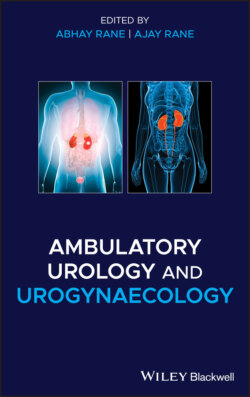Читать книгу Ambulatory Urology and Urogynaecology - Группа авторов - Страница 18
Anaesthesia
ОглавлениеPre‐operatively, a full anaesthetic assessment should be performed, including previous anaesthetic history, post‐operative nausea and vomiting (PONV) risk, and an airway assessment. PONV a common complication of anaesthesia, occurs most often in females, those with a similar past history, those with motion sickness, nonsmokers, and those requiring post‐operative opioids (Apfel 1999). Pre‐operative assessment should aim to identify risk factors for difficult pain control allowing for individualised perioperative analgesia planning.
Most current anaesthetic agents convey predictable and rapid recovery. Desflurane‐based anaesthetic has been reported to have the most predictable emergence from anaesthesia (Dexter 2011; Watchel 2011), although desflurane and sevoflurane‐based anaesthesia appear to provide equal numbers of patients eligible for fast‐tracking (White 2009). Propofol is frequently used for induction and maintenance of ambulatory anaesthesia, due to rapid metabolism and emergence, few side‐effects, and low rates of PONV.
Depth of anaesthesia monitors, such as Bi‐spectral Index (BIS), facilitate drug titration and have been shown to reduce drug consumption, reduce PONV (Liu 2004), and reduce rates of post‐operative cognitive dysfunction in elderly patients (Chan 2013).
Post‐operative pain will vary according to patient factors as well as the specifics of the surgical procedure and anaesthesia used. Utilising minimally invasive surgical techniques and regional anaesthesia are obvious ways to reduce pain. Regional anaesthetic techniques such as peripheral nerve blockade or neuraxial blockade, can mitigate the side effects of general anaesthesia such as PONV and aspiration pneumonia and may accelerate recovery by facilitating early analgesia (Moore 2013) and reducing opioid requirement. For neuraxial blocks, drug selection and dosing must be carefully considered so that prolonged effects do not delay discharge.
A number of antiemetics have been investigated and compared for efficacy. The 5HT3 antagonists such as ondansetron have good efficacy, especially when used in combination with dexamethasone. These should be started before the end of anaesthesia (Tang 1998) and continued in the community if necessary. Side effects should be evaluated when choosing an agent. Dexamethasone should be avoided in patients with lymphoma because of risk of tumour lysis syndrome. Ondansetron should be avoided in patients with, or at risk of long QT.
